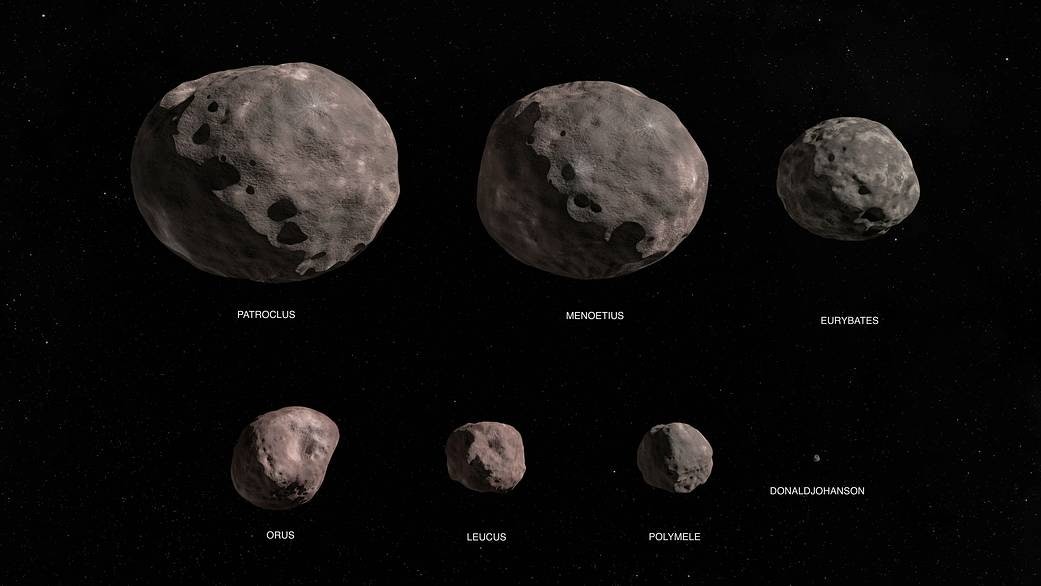
NASA’s Lucy mission — set to explore a group of asteroids that follow behind and in front of Jupiter's orbit — hit a snag recently when one of its solar arrays failed to unfurl. On Thursday, the Lucy team announced that it would perform two maneuvers to fully unfurl its solar arrays.
The Lucy mission will study the crumbs leftover from the early Solar System, and it needs to reach Jupiter’s orbit, where two gravitational crevices have collected them. Operating farther from the Sun requires big solar arrays to capture the diminishing sunlight for energy, so Lucy was equipped with two peeper-like solar wings.
Shortly after its October 2021 launch, NASA officials noticed something was wrong with one of the solar arrays. Its readings were unusual, and personnel soon realized that the lanyard wrapping around one solar array hadn’t fully retracted, blocking some sunlight from reaching the panels. An engineering model suggests that upon retracting, “the lanyard may not have wound on the spool as intended,” NASA reported one month after launch.
According to NASA officials, the faulty array is between 75 percent and 95 percent deployed.
The space agency has been monitoring the situation for the last half-year, and on April 18, they decided on a plan forward they hope will solve the issue.
They will perform two steps over the next several months to see if the solar array can be fully deployed.
The first will happen on May 9, when they will attempt to reel back some of the lanyard in a quick maneuver. The team anticipates that this single operation won’t be enough, so they are planning a second array deployment task for a month later, which will hopefully successfully latch the solar array. The month between each task will give the teams time to analyze the best way to perform the second maneuver.
“The solar array was designed with both a primary and a backup motor winding to give an added layer of reliability for the mission-critical solar array deployment. Lucy engineers will take advantage of this redundancy by using both motors simultaneously to generate higher torque than was used on the day of launch. Ground tests show that this added torque may be enough to pull the snarled lanyard the remaining distance needed to latch,” NASA officials shared in a mission update published last Thursday.
So far, the issue hasn’t affected the mission too severely. “That solar array is generating nearly the expected power when compared to the fully deployed wing. This power level is enough to keep the spacecraft healthy and functioning,” NASA officials shared three days after launch.
Having fully charged batteries is important. Lucy is heading out to Jupiter at a speed of roughly 67,000 mph (108,000 kph) to study the Trojan asteroids, peculiar rocks significantly different from those found between the orbits of Mars and Jupiter in the Asteroid Belt.

The Trojans are leftover pieces from the formation of the Solar System that were looped into Jupiter’s orbit and thus avoided being ejected into deep space. The Trojans are trapped in two gravitationally stable spots called Lagrange Point 4 and Lagrange Point 5, created by the interaction of the Sun and Jupiter.
Lucy will study seven asteroids over 12 years, so having fully-operating batteries will be critical. The team also hopes that, if the lanyard cannot be retracted and the solar array has to stay the way it is, the main engine burns won’t mess with the solar array.

Lucy will reach its first target in 2025, an Asteroid Belt object dubbed Donaldjohanson. After its encounter with that asteroid, the craft will continue toward the group of Trojans residing in front of Jupiter, targeting a 2027 arrival. After that, a maneuver will bring it back to the inner Solar System to use Earth for a gravity assist in 2031, only to swing back out for a second Trojan trip in 2033 toward the trailing asteroids.
The mission is named after the three million-year-old hominid fossil discovered in Ethiopia in 1974. Donaldjohanson is named after Lucy’s discoverer. “Lucy” is both an homage to the science of origins and likely a nod to The Beatles’ song that inspired the fossil’s name, “Lucy in the Sky with Diamonds.” Hal Levison, Lucy principal investigator, has previously compared the Trojans to jewels for their “immense scientific value.”







